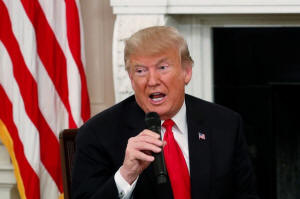|
Trump hardens stance on Mexico border,
says 15,000 troops could be sent
 Send a link to a friend
Send a link to a friend
 [November 01, 2018]
By Jeff Mason and Idrees Ali [November 01, 2018]
By Jeff Mason and Idrees Ali
WASHINGTON (Reuters) - U.S. President
Donald Trump said on Wednesday the United States could send as many as
15,000 troops to the border with Mexico, as he hardens his stance
against a caravan of migrants fleeing violence and poverty in Central
America.
The numbers cited by Trump are significantly higher than defense
officials have disclosed. The Pentagon said on Monday it was deploying
more than 5,200 troops to the border but that the number would rise. On
Wednesday, it said more than 7,000 troops would support the Department
of Homeland Security along the border.
Several groups, including the American Civil Liberties Union, have
accused Trump of politicizing the military ahead of next week's
congressional elections with his plans to use active military personnel
to buttress border patrol efforts.
"As far as the caravan is concerned, our military is out ... We'll go up
to anywhere between 10 and 15,000 military personnel, on top of Border
Patrol, ICE and everybody else at the border," Trump told reporters at
the White House.

Trump did not say how many of those 15,000 would be National Guard.
There are already 2,100 U.S. National Guard forces at the border, sent
after a previous Trump request in April, and they are authorized to go
up to 4,000.
If 15,000 troops were drawn into the effort, it would mean there would
be more U.S. troops on the border with Mexico than there are in
Afghanistan, which has become America's longest conflict.
Trump has sought to use immigration as an issue to motivate Republican
voters ahead of the Nov. 6 elections, where Republicans will seek to
maintain control of both congressional chambers.
As a presidential candidate before the U.S. election in 2016, Trump
promised to harden immigration laws and build a wall along the southern
border with Mexico, but implementation of his signature campaign promise
has been slow.
A caravan of Central American migrants estimated to number at least
3,500 people left Honduras in mid-October and is now in southern Mexico
on its way to the U.S. border.
"WE DON'T DO STUNTS"
Before Trump's comments, U.S. Defense Secretary Jim Mattis on Wednesday
rejected criticism that deploying thousands of troops to the border with
Mexico was a political stunt.
[to top of second column]
|

President Donald Trump speaks during the "Our Pledge to America's
Workers" event at the White House in Washington, U.S., October 31,
2018. REUTERS/Kevin Lamarque

"The support that we provide to the secretary for homeland security
is practical support based on the request from the commissioner of
customs and border police, so we don't do stunts in this
department," Mattis said after a meeting with his South Korean
counterpart at the Pentagon.
Republican lawmakers and other Trump supporters have applauded the
deployment. But critics argue Trump has manufactured a crisis to
drive Republican voters to the polls.
"The move to send 5,200 active duty troops to the southern border is
a craven political stunt that sets a bad precedent and is arguably
an abuse of power," said Kelly Magsamen, a former senior Pentagon
official who is currently with the Center for American Progress
left-leaning think tank.
Trump's decision to call in the military appears to be a departure
from past practice. In recent years, such operations have been
carried out by National Guard forces, largely part-time military
members often called upon to respond to domestic emergencies.
A U.S. official told Reuters that as of Wednesday the Pentagon had
identified more than 7,000 active-duty troops, which included about
2,000 on standby, that could be deployed to the border with Mexico
if needed.

Many basic questions remained unanswered days after the Pentagon
announcement, including the scope of the mission as well as the
Pentagon's assessment of any threat posed by arriving migrants.
(Reporting by Jeff Mason and Idrees Ali; Writing by Makini Brice;
Editing by Chizu Nomiyama and Alistair Bell)
[© 2018 Thomson Reuters. All rights
reserved.]
Copyright 2018 Reuters. All rights reserved. This material may not be published,
broadcast, rewritten or redistributed.
Thompson Reuters is solely responsible for this content. |